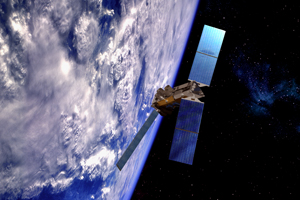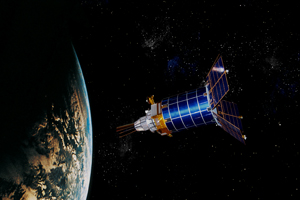Several efforts—developing both inside and outside of the United States Air Force—may in the next few years bring much of the nation’s space surveillance capability out of the secretive “black” world and into the open.
The trend is toward relying on unclassified satellite systems to acquire vital space-based intelligence-surveillance-reconnaissance (ISR) data. In time, said officials, the openly acknowledged space systems could increasingly supplant the highly classified satellites of today.
The shift, if it comes to fruition, will be welcomed by theater commanders, among others, because it would pay immediate dividends in the form of greater information sharing.
The change has been going on for some time. Already, USAF has come a long way toward openness since the 1991 Persian Gulf War, when commanders were often frustrated that they could not get their hands on data from intelligence satellites. At that time, Lt. Gen. Charles A. Horner, the commander of air operations in both Desert Shield and Desert Storm, charged that overclassification of data made it difficult to share important information with American and coalition forces.
Despite improvements, the vital work of combat staffs is frequently complicated by difficulty in obtaining or distributing classified data, according to current and former Air Force officers.
Satellites should not be viewed in isolation, cautioned Col. George V. Eichelberger, Air Force Space Command’s director of intelligence. On-orbit systems are just one component of the ISR equation, which involves multiple types of data from a variety of sources, he said.
 |
An artist’s conception of a Space Radar satellite, a program that is said to be fraught with technical challenges. (Illustration by Erik Simonsen) |
Compared to more traditional aerial ISR assets, satellites don’t have much “dwell time” over areas of interest or high image resolution, Eichelberger said. However, satellites do have one awesome advantage: They can pass over any spot on the globe, even areas denied to friendly aircraft due to overflight restrictions or air defense systems. Space systems can also offer critical coverage while aerial assets are still arriving on-scene during the initial phases of an operation.
Because of the extreme advantages offered by this combination of aerial and space-based surveillance platforms, it is not likely that either will dominate the mission any time soon, according to service officials.
The primary unclassified Air Force space system in the ISR arena today is the Defense Support Program (DSP) constellation of satellites. DSP was conceived primarily for strategic early warning of ballistic missiles fired at the United States, and was built by Northrop Grumman.
In the years since 1970, when the Air Force launched the first DSP spacecraft, the service has found the satellites increasingly useful to support tactical users and the Intelligence Community. The last of the DSP satellites launched in November 2007.
One example of the tactical use of DSP satellites was during Operation Iraqi Freedom, when they were used to spot mobile Scud missile launchers, Eichelberger said. The DSP satellites’ infrared sensors served as the initial indication of a missile firing; the information was used to cue other assets that homed in on the launchers.
Information in 10 Seconds
The Air Force’s capabilities in this area will improve significantly as it replaces the DSP satellites with the Space Based Infrared System (SBIRS) constellation, which is built by Lockheed Martin Space Systems. The Air Force currently operates a SBIRS sensor aboard a classified satellite in a hi;ghly elliptical orbit, and plans to begin launching dedicated SBIRS satellites in late 2009.
The DSP satellites rotate to provide full hemisphere coverage, which means that they can deliver information about a “heat generating event” on the battlefield or elsewhere every 10 seconds.
While this capability has been useful, the SBIRS satellites will be able to deliver more frequent updates. This is because only a portion of the SBIRS scanning sensor moves while the spacecraft platform itself remains stationary.
The SBIRS satellites also feature a staring sensor not found on the DSP constellation that can focus on a particular area of interest to provide even more frequent updates.
The improved sensitivity and more frequent updates from the SBIRS satellites are expected to help US forces spot mobile launchers faster, improving the likelihood that they can be destroyed before speeding away. Targeting mobile launchers—always a difficult task—has become increasingly challenging as enemies work to develop missiles with shorter burn times and dimmer heat signatures.
The SBIRS satellites will also be far more capable of spotting tanks and other ground vehicles, according to Air Force officials. The SBIRS birds may also be useful for bomb damage assessments of targets such as ammunition dumps, as munitions that struck such targets would likely trigger secondary explosions that could be picked up by the satellites.
If the United States were to come under missile or rocket attack, the SBIRS satellites should also help intelligence officials learn more about the nature of the attack. Longer looks at the incoming missile, made possible by SBIRS’ staring sensor, could help characterize what type it is, which better enables intelligence officials to determine the missile’s range and possible impact point.
Beyond DSP and SBIRS, most other unclassified space-based ISR capability comes from the commercial satellite imagery industry.
The Air Force and other military services generally acquire commercial satellite pictures through the National Geospatial-Intelligence Agency (NGA) in Bethesda, Md., which buys it from companies such as Digital Globe of Longmont, Colo., and GeoEye of Dulles, Va.
Users of commercial ISR data are often willing to sacrifice the unparalleled resolution of classified satellites for imagery that can be easily shared among US and coalition forces, as well as civil government agencies and nongovernmental organizations during relief efforts.
In some cases, as in the development of broad area maps of a battlefield—or views of zones affected by hurricanes, floods, or other natural disasters—commercial satellites can do the jobs just fine. In many of these cases, the high resolution that classified intelligence satellites provide is simply not necessary.
While commercial imagery has become increasingly valuable to the US military, there is an obvious drawback to its availability. Some enemies that previously did not have the money or expertise to develop their own spy satellites now have access to their own eyes in space, Eichelberger said.
Even applications available without charge on the Internet, such as Google Earth, can provide valuable ISR data both to the US and its adversaries.
 |
Many satellite images are easy for the public to access, such as this one provided by Google Earth. |
Smaller Sats For Smaller Jobs
The quest for quickly available ISR capability also led to the Operationally Responsive Space mission. One way of speeding this up is through the construction of small satellites that can be built quickly and relatively cheaply compared to the satellites used to support most military operations today.
Though the potential has been untapped to date, through ORS the Air Force could increase its use of unclassified space assets and bring new capabilities on-line much faster. The current development cycle—from requirements generation to satellite launch—can take more than 10 years in cases like SBIRS.
Even advocates for the ORS concept say that small satellites will not replace the larger satellites such as DSP that the Air Force uses today, but advocates believe ORS can offer a valuable new capability. The small satellites would likely be used to augment existing systems or replenish constellations that have been disrupted or destroyed by events such as solar flares—or enemy attack.
ORS appears to have recently taken on a higher priority within the Air Force. (The year 2007 saw the creation of an ORS program office at Kirtland Air Force Base in New Mexico.)
Increased priority is supported by the service’s planned budget between 2009 and 2013. Though ORS funding is less than most satellite efforts, it still saw a significant increase from the plan a year ago, as planned five-year funding increased to $549.3 million from $322.3 million.
While ORS is intended to address a variety of missions, Eichelberger said the vast majority of users polled have said that they would like to see ISR payloads aboard the small satellites.
In addition to delivering ISR capabilities quickly, ORS aims to put the small satellites directly under control of theater commanders, rather than forcing them to go through middlemen to task the sensors and relay the information. Even without the resolution of classified systems, small ORS satellites may be able to offer valuable additional views of an area of interest, according to Col. Kevin McLaughlin, director of the ORS program office.
The Air Force is still moving ORS from the realm of experimentation to operations. The service took a first step in this direction in December 2006 with the launch of TacSat-2, which featured an imaging sensor and a signals intelligence payload.
McLaughlin said work on projects such as TacSat-2 has been “very successful” thus far, but the military still has “a long way to go in terms of building satellites faster and launching faster, especially on a routine basis.”
The work with TacSat-2, which wrapped up in December 2007, has raised important issues. These lie outside of merely developing the technology needed to address future military ORS missions.
“Responsively delivering ORS capabilities is as much about [concepts of operations], processes, policies, procedures, authorities, and relationships as about technology,” McLaughlin said. “The TacSat series of satellites is paving the way toward operational capabilities,” by developing “all of the enablers needed to make ORS operational satellites successful, both technical and nontechnical. While ORS will be building small satellites, that is just one facet of ORS’ overarching focus” on quickly delivering robust capabilities to the field.
One incident that ORS advocates cited as a significant frustration, but that ultimately became a valuable learning experience, was the Air Force’s inability to turn on the main sensors aboard TacSat-2 for several months following its launch. The problem began with a debate between the service and the Intelligence Community about tasking authority—who had the right to turn the sensors on
ORS proponents were not pleased by the delay because it cut into the time available to experiment with TacSat-2. Officials added, however, that the process highlighted the tasking issue so that it could be resolved before similar satellites are launched for military operations.
The next ORS satellite to launch is expected to be TacSat-3, currently scheduled for launch this summer. TacSat-3 features a hyperspectral imager built by Raytheon Space and Airborne Systems, which will give military officials the chance to experiment with the ability to use a small satellite to see through enemy attempts to camouflage buildings and vehicles.
In addition to future use aboard ORS satellites, sensors demonstrated through the TacSat program, such as hyperspectral imagers, could also find themselves deployed on new unmanned aerial vehicles, McLaughlin said.
The ORS office is hoping to initiate work this year on another satellite called ORSSat-1, which will have electro-optical and infrared sensors, McLaughlin said. An industry official said that the satellite’s combination TV/heat sensing payload may essentially be a version of the sensors used on the U-2 aircraft, modified to fly in space.
The ORSSats, funded by the ORS program office, are built with the intention of serving as prototypes for future operational spacecraft, McLaughlin said, while the TacSats reflect more of the research and development focus of the military laboratories that build and fund them.
 |
An artist’s conception of a satellite in the Defense Support Program constellation. DSP is the primary unclassified USAF space system in the ISR arena today. (Illustration by Erik Simonsen) |
ORSSat-2s and TSAT, Too
The labs will likely continue to build TacSats, as they may feature technology that is not ready for use in operational settings, he said.
Depending on its budget and workload, the ORS office may also begin work on ORSSat-2 this year, McLaughlin said. One option for the spacecraft’s payload is a hyperspectral imager.
“The immediate contribution of any one small satellite would be small,” relative to the entire portfolio of ISR capabilities, McLaughlin said. “The larger impact will be gradual and evolutionary as ORS capabilities are proven” over the next decade.
One way that the Air Force could boost its ISR coverage with operationally responsive satellites is by working with its allies, said Col. Thomas A. Doyne, a space advisor in the Office of the Secretary of Defense.
By collaborating on block buys of small satellites, as USAF has done with allies on a variety of fighter aircraft programs, the service could bring down the cost of buying the satellites. The US could also participate in an arrangement where each nation could take advantage of the information gathered by others’ assets, he said.
Another significant source of ISR data from space could come from Space Radar satellites—assuming that program ever gets off the ground. The Space Radar budget and many of the details about the effort are classified, but the Air Force-National Reconnaissance Office partnership is struggling for funding on Capitol Hill.
Space Radar was initially conceived as offering continuous tracking of mobile targets around the world, regardless of time of day or weather conditions. However, the cost of developing a constellation with enough satellites to maintain continuous tracks became prohibitive. The current Space Radar concept of operations is more integrated with aerial assets.
The House Appropriations Committee described the effort scathingly in a report accompanying 2008 defense budget legislation. Space Radar, according to the committee, is fraught with technical challenges, is potentially duplicative of the moving target tracking capability conducted by aircraft, is “not affordable,” and is “a lower priority than other defense requirements.”
The Space Radar satellites are also intended to serve the Intelligence Community by offering high-resolution imagery of ground areas. In addition to the difficulty finding support on Capitol Hill, the program has been hampered by disagreements between the Air Force and the NRO over some familiar issues—including who should have operational control of the satellites.
To properly take advantage of the data from new systems such as Space Radar, the Air Force will need to find ways to handle the enormous flow of data that they will provide. This will entail the development of new communications satellites like the Transformational Satellite Communications System to pass the data from space to Earth, as well as ground systems for the tasking, processing, exploitation, and dissemination of the data.
Without addressing those issues, the Air Force risks gathering a tremendous amount of ISR data, and then having it “fall on the floor of a ground station,” Eichelberger said.
Jeremy Singer is a Boston-based staff writer for Space News. He covers the Pentagon and is the editor for special projects. His most recent article for Air Force Magazine, “Laser Links in Space,” appeared in the January issue.
